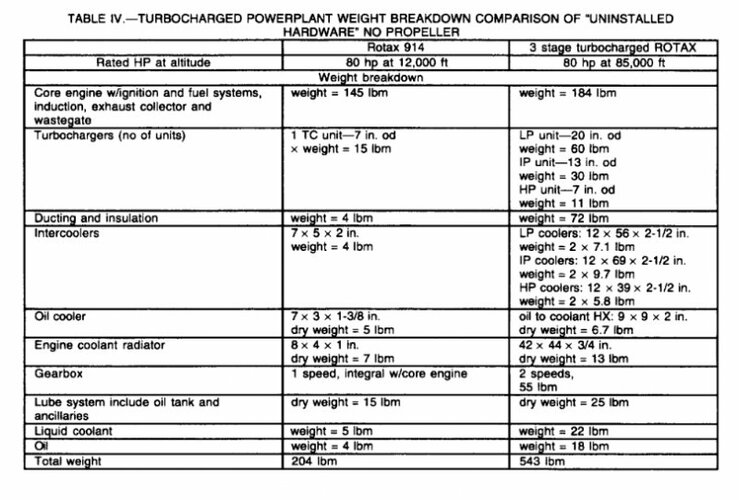So, I believe you’re right icing might occur and not being totally washed of by deicing fluid, but this is not a safety concern and will only happen occasionally. Once the plane has reached its cruise height, icing want be a problem anymore. In case you will fly a long distance over water, you need to be sure, that no icing occurred during the starting phase or you need to get rid of it by choosing the right atmospheric conditions. I guess, in more than 90 % of the flights, icing is no problem an the Otto Celera can make full use of the laminar flow optimization.
The Dassault Falcon flies as high as the Celera is intended to do, so it is possible to certificate planes for that height. Maybe this is not possible for airliners, but for smaller business jets (and surly as well for "business props").
BMW had a production Diesel engine with six cylinders and 5 turbos and three stages (2 x high pressure, 2 medium pressure, one low pressure turbo). Multi stage supercharging is nothing new, but built for millions of cars and almost all of the trucks.
For a flight height of 15.000 m (Otto Celera) even a two stage charging system would work:
.The air density at 15.000 m is about 0,193 kg/m³, the air speed is 205 m/s, so we can add some dynamic pressure to this:
With 80 % pressure recovery we can add ps=(0,193/2)*205²= 4055 Pa. The atmospheric pressure is 12044 Pa so the total pressure will be 16100 Pa. The pressure increase of about 33% will not fully correspond in a density increase due to warming an due to losses in the pressure recovery. The temperature will rise about 8.5 % so that the density with 100 % pressure recovery is roh = 0.193 * (16100/12044)*(1/((16100/12044)^0.285) = 0.2375 kg/m³. Let’s estimate some pressure losses (80 % pressure recovery) so we have a p0 of 0.229 kg/m³ and a p0 of 14820 Pa or 0,148 bar.
The engine will propably need about 3.2 bar absolute, so the required pressure ratio is about 22.5 (taking account of some flow losses), this is about 4.75 per stage. This is quite high under normal circumstances, but the maximum pressure ratio of a turbocharger is usually limited by the compressor outlet temperature, because the max. tolerable temperature of the aluminum compressor wheel is limited to around 250 °C. Since the incoming air is extremely cold (216 K or -57 °C) a pressure ratio of 5 or even more should be totally OK for the low pressure turbo. So a two stage charging system with two pressure ratios of 5 (low pressure) and 4.5 (high pressure) would be totally feasible.
I’m not doing the turbomatching for Redair for free (they can do it themselves, I’m sure…), but I took a look at Garret. For the matching, we need to be aware, that the density of the low pressure turbo is only about 1/5 th of the sea level air density and so we can only assume 20 % of the norm mass flow in a compressor map (the rest stays almost the same). With around 370 kw engine power, an AFR of 18 and SCF of 220 g/kwh we will have an air mass flow of about 0.4 kg/s. Because of the low density, this corresponds to 2 kg/s in a compressor map or 1 kg/s if we are using two low pressure turbochargers, which makes sense in a V-engine. So here is one (probably not the optimum) turbo that could do the job for one half of the engine:
https://www.garrettmotion.com/wp-content/uploads/2018/05/Comp-Map-GTX5533-88mm-2-scaled.jpg
If you take a look on the outer dimensions (
https://www.garrettmotion.com/wp-content/uploads/2020/02/GAM-Flange-Diagram-G57.pdf) this is nothing extreme cumbersome and could be easily applied to the Redair (or even better) engines. As said, multi stage turbocharging is a standard solution for Diesel engines even for road vehicles. Keep in mind, that the high-pressure turbo can be much smaller because the density will be about 5 times higher.
The weight this turbocharger is around 14 kg (
https://www.turbosbytm.com/de/g57-3000-super-core), so a second stage (2x) would add about 30 kg to the engine.
The load cycles for turboprops are indeed a factor and a main reason why twin piston engine planes are sometimes kept in service a long time for island hopping. Turboprops are absolutely unsuited for that, because of excessive fuel consumption and fast aging. Turbines are also much more expansive even than aero Diesel engines which are built in much smaller numbers. With the much better part load efficiency, the best angle of attack can not only be achieved with altering the height but also by altering the speed. In a turbine, you would loose so much engine efficiency, that there is no gain by flying slowr.
Flat rating of a turbine means, you take an oversized turbine and don’t make use of the power potential.
I know an engine design which is much better than the Redair engine (lighter, more efficient, longer lasting with lower rpm) but the Redair engine is a good starting point. The Continental Aero Diesels are much more reliable than their gasoline counterparts, despite being much more complex. The FADEC system is the cause of the increased reliability. Operating spark, mixture, speed manual by a pilot is extremely anachronistic and the main reason for engine failures (after fuel issues). Diesel engines in trucks are extremely long lasting and reliable, Aero engines could be the same. One really nice feature about the Redair Diesel is, that both sides of the engine run independently, with two separated engine controls, cooling systems, charging systems, injection systems, so that in almost all failure scenarios you can still limp home with one side of the engine. This approach is even safer than a twin engine, since a failure of one side of the engine can be handled much easier by the pilot than an unsymmetrical thrust.







